Strengthen your brain to get and maintain a great body. What does brain function depend on?
Fifty percent of the brain's work is related to vision. Your appearance affects your well-being. Both are important for success in your career and relationships. It's about not about vanity, but about health. To look and feel your best in the best possible way, you should optimize your brain function.
I live in Newport Beach, California. Our city is often called “silicon”, because on the streets and beaches here they wear so much of this cosmetic plastic as nowhere else in the world. One of my friends jokes that Newport Beach is an unsinkable city because all the women will float to the surface anyway.
Unfortunately, people (not just in Newport Beach, but everywhere) care more about their face, bust, belly, and butt than they do about their brain. Although it is the brain that is the key to the desired beauty of the face, chest, abs and in general good health. It is malfunctions in the brain that usually destroy our bodies and cause early aging. It is our brain that decides whether to get us out of bed in the morning to exercise and strengthen the body, or to press the snooze button and cancel the warm-up. It is the brain that pulls us away from the dinner table and tells us that enough is enough, or allows us to eat a second bucket of Rocky Road hard ice cream until we swell up like a balloon. It is our brain that finds ways to cope with stress and relax (and we look great) or sends stress signals to the body and creates wrinkles on the skin. And it is he who ignores cigarettes, caffeine and alcohol, maintaining our good shape, or gives permission to smoke, drink a third cup of coffee or a third glass of wine, and thereby ages our body and spoils our mood.
The brain is the command center of the body.
If you want your body to change, you always need to start with your brain.
I became interested in the connection between the body and the brain more than thirty years ago. In college, I was very impressed by the work of oncologist O. Carl Simonton, who taught patients to use visualization to help the body fight cancer. At the Faculty of Medicine we were taught medical hypnosis, and I saw how powerful impact it has an effect on physical recovery. I have personally seen that hypnosis helps treat headaches, irritable bowel syndrome, chronic pain, insomnia, tremors, arrhythmias and promotes weight loss.
Then I trained in biofeedback techniques. And when I taught patients to use the power of the brain to warm their hands or breathe into their bellies, their entire body relaxed, decreased arterial pressure and the headaches went away.
The missing element
It wasn't until 1991 that I truly began to understand the true nature of the brain-body connection. That year, at the Amen Clinic, we began to use a brain imaging technology called SPECT. SPECT is single photon emission computed tomography.
It allows you to take pictures of the blood supply to the brain and thereby observe active and passive zones in it. Unlike magnetic resonance imaging and conventional CT scans, which simply show the structure of the brain, SPECT shows how the brain functions. Learning how the brain works has made a huge difference in my professional and personal life. Previously, I was a simple therapist who had long lacked information to more effectively treat patients.
After scanning the first patient's brain, I was delighted to discover that SPECT vital information about brain function, which cannot be obtained during a conversation at a reception. The scans helped me and my colleagues work better. Since 1991, we have performed over 55,000 scans at Amen Clinics (more than any other organization in the world). By analyzing images in the context of a patient's individual medical history, we have learned to better diagnose and treat disorders such as attention deficit disorder, depression, anxiety, aggression, learning problems, memory impairment, brain injury and addictive behavior.
In addition, I discovered that by improving patients' brain function, we also helped them improve their body and overall life. I received compelling evidence of this several years ago when I developed a home treatment for anxiety and depression. To test the course, we recruited a group of 90 people. The results were amazing. As I expected, the majority experienced decreased levels of anxiety and depression. But that's not all. Many said that after 12 weeks of the program they had lost 10-15 kg of weight. This unexpected result suggests that when the brain works better, it helps the body get rid of extra pounds.
Our brain scans help explain why people behave the way they do.
We found the missing link - we saw what was happening in the brain, in order to subsequently correct the body with the help of this knowledge.
Take a closer look at yourself in the mirror. When your skin looks dry, you reach for moisturizer. If you notice a pimple, apply an anti-acne product to it. If you see split ends in your hair, sign up for a haircut. When a Newport Beach resident notices a few wrinkles on himself, he calls a cosmetologist and arranges for a Botox injection. In a word, every time we notice a defect in the body, we try to eliminate it, ourselves or with the help of a specialist. But most people don't even think about brain health because it doesn't seem to be immediately visible. However, many people need help.
Let's look at pictures of a healthy and problematic brain. A healthy brain is almost completely and symmetrically active, with the most intense functioning of the posterior brain structure, which is called the “cerebellum.” An unhealthy brain shows that some areas are working too hard and others are not working hard enough. Figure 1.1 shows a SPECT scan of the brain of Anna, who is 82 years old. This is a very healthy brain, you would think that its owner is 30 years younger than she actually is. Anna is quite healthy and does not use medications. She - loving wife(58 years married!), mother and grandmother. She has a sharp mind, is energetic, shows a great interest in life, and is involved in the activities of the local community and church parish.
Another picture shows the brain of Becky, 44 years old. She came to us about impulsiveness and excess weight. With a height of 150 cm, she weighed almost 100 kg and tried unsuccessfully to lose weight more than once. When we scanned her, it turned out that she had reduced activity in her cortex. frontal lobes(Fig. 1. 2), possibly due to a traffic accident that happened when she was a child. The frontal cortex is responsible for planning, decision making, and impulse control. We prescribed Becky treatment to restore the functions of her frontal cortex. After it (Fig. 1. 3), her impulsivity decreased significantly and she was able to adhere to the rules of the health program, which allowed her to lose 40 kg in 2 years.
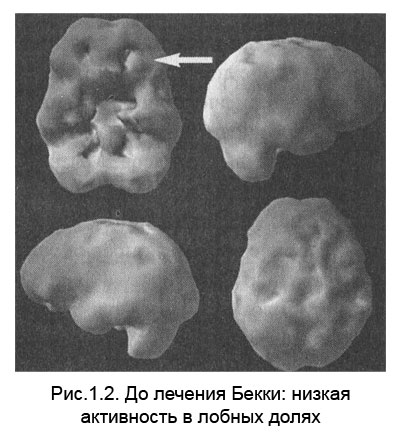
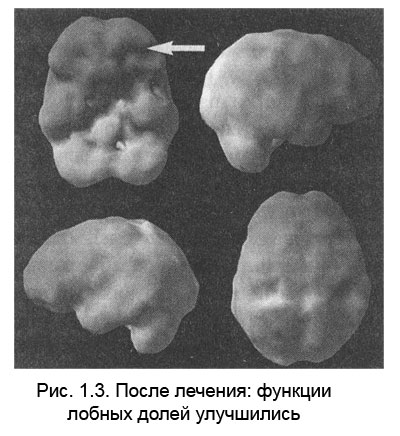
By scanning the brains of patients, we learned that impulsivity is not due to a lack of willpower or moodiness, as is commonly believed. In fact, many people simply have a weak frontal cortex, due to traumatic brain injury, exposure to toxic substances, or inherited disorders such as attention deficit disorder (ADD). When we prescribe treatment, patients manage to do something that was not possible before: stick to a diet and lead a healthy lifestyle.
Moreover, while studying the brain, I stopped believing that compulsivity (obsessive actions) is characteristic only of rigid, inflexible people prone to total control. I have seen that the front part of the brain of such people works too hard. When did we calm her hyperactivity with the help food additives or medications, patients stopped eating too much or living in constant stress. I realized that if you want to change your body, you first need to change your brain. Understanding and optimizing the functioning of the brain is the missing element to success in the pursuit of a beautiful body.
The brain can change the body
The connection between the brain and body is truly amazing. Here are three examples.
1. My first wife, Robin, and I tried for several years to have a third child. Robin had a child from a previous marriage, Anthony, whom I adopted, and we also had a daughter, Breanna, but the third never worked out. She even sent me to a urologist to check my fertility - not the most pleasant procedure. One day, when I, four-year-old Breanna, and nine-year-old Anthony were at home (Robin had gone to a school meeting), we heard crying. We searched the house but found nothing. The sounds came from the attic. I took out a ladder and a flashlight, climbed into the attic and found a kitten a few hours old that had been abandoned by its mother. He was still blind and cried weakly. When I brought the kitten down, the children were very happy. The local veterinarian said over the phone that the baby was unlikely to survive and the best thing to do was drown him in a bucket of water. However, my son and daughter looked at me expectantly, and I asked the veterinarian to give us other advice. Reluctantly, the veterinarian advised stimulating the kitten to go to the toilet using a warm, damp cotton swab(I didn’t know such facts), told me what kind of cat “baby” food I should buy at the pet store, and recommended keeping the foundling warm under a lamp. However, he did not give us any hope. When Robin returned home, her maternal instinct kicked in immediately. She cared for the kitten, even getting up at night to check on him. Aipo (that's what we called him) was surrounded by care and felt great. And three weeks later Robin became pregnant. Maternal instinct changed the receptivity of her body.
2. Larry and I worked together in my father's grocery stores as teenagers. I saw him periodically on various business and family occasions. During last meeting At my father's 80th birthday, Larry looked 20 years older than his 54 years. His hair turned completely grey, many wrinkles appeared, and his skin became sallow in color. His daughter had died of cancer 10 years earlier, and his wife had died of the same type of cancer the year before. The extreme stress had a devastating effect on Larry's body.
3. Recently, while going on my TV show “Change Your Brain, Change Your Life,” I once again visited the television company’s offices in Atlanta. Finance Director Alicia Steele picked me up at the hotel to take me to the studio live broadcast. We had met her before, but this time Alicia looked different: younger and more energetic. I asked her what she did about it. And she replied that since our meeting she had been eating healthier, taking fish oil, drinking less alcohol and managing stress better. She took the long version of the brain questionnaire on our website and learned that she likely had low frontal cortex activity, so she started taking a supplement called S-adenosylmethionine (SAMe). During the time that we didn’t see each other, she managed to lose 8 kg and convince her husband to do exercises too. A week before my arrival, an accident happened to the producer of her station, which disrupted the entire work schedule. Previously, Alicia said, such stress would have brought her to tears, but now she has learned to adapt to change and get rid of automatic negative thoughts. When she changed her brain, her body improved, her work and even her family changed.
The story of the kitten shows that when a woman begins to behave like a mother, chemical changes in her brain send signals to the body, adapting it to conception. Larry's story illustrates how much stress can wreak havoc on the body. And Alicia's story teaches that if you manage stress and stick to a wellness program that suits your brain type, you can look and feel younger. Think about it. Use your brain to create the perfect body.
Our recommendations are not suitable for everyone
Alicia's story illuminates important point, which I will talk about a lot in this book. Our recommendations don't work for everyone, which is why most weight loss programs don't work. Individual recommendations based on brain type are often needed. Because Alicia likely had decreased frontal cortex activity, she required stimulant supplements such as methionine (SAMe).
If this part of the brain is overactive, a person may need anti-anxiety medications that enhance the effects of the neurotransmitter serotonin, such as a 5-hydroxytryptophan (5-HTP) supplement. And taking SAMe, such a person may become more anxious. It is very important to know how your brain works. As you read the book, note which recommendations suit your individual type.
Welcome to the world of brain-body connections
Over the past few decades, scientists and doctors have been intensively studying the brain-body connection. A growing body of scientific evidence supports the concept that the mind has strong impact on appearance, mood, stress levels and overall health. A whole branch of alternative medicine has emerged that deals with the interaction between the state of mind and body.
I am often asked whether the mind and brain can be considered separate from each other. My answer, based on over 55,000 brain scans, is no. The mind and brain are completely dependent on each other. Take, for example, Alzheimer's disease, which is clearly a purely brain disorder. As the disease progresses, patients lose their minds. When you lose brain tissue (Fig. 1.4), memory and the ability to think rationally are lost.
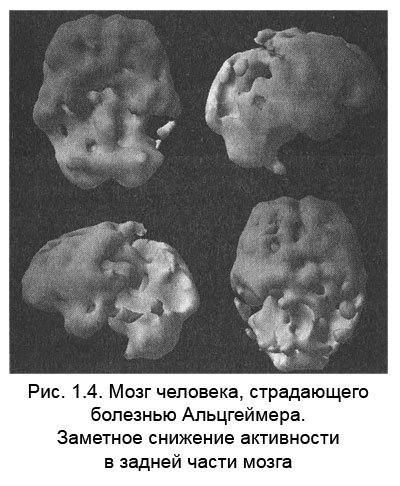
Or consider the problem of traumatic brain injuries. Becky's brain scan (Figures 1 and 2) showed damage to the frontal cortex. Damage to the brain leads to impaired mental abilities and poor health of the body. As Becky's brain returned to normal, she regained control of herself and regained her health.
Take advantage of the brain's connection to the body
If you're already reading this book, it means you want to change something in your body: lose belly fat, make your skin look younger, become more energetic, get fewer colds, reduce the frequency of headaches, or lower your blood pressure without taking medications. Like many people, you probably know what you need to do to achieve these goals, but don't do it. Why? Because you don't care about your brain. If you are trying to get rid of fat around your waist, you should optimize the functioning of your frontal lobes. If you want to say goodbye to headache attacks, you need to calm your brain. If you want to reverse your skin condition, you need to rejuvenate your brain.
In this book, I offer recipes for helping the brain to improve the body. But first you need to love your brain and understand how it affects your body. These easy-to-follow steps will teach you how to use your brain to strengthen your willpower and break body-damaging habits. You'll learn how to change your weight, improve your skin, and strengthen your heart. In addition, you will learn to concentrate better, be able to store energy, relieve stress and strengthen your memory. We will find out what to “feed” the brain to look and feel younger. And you'll discover that getting enough sleep can prevent weight gain and improve your appearance. Among the many prescriptions on these pages, you'll find recommendations on how to balance your hormones to rejuvenate your brain and body.
One of the most powerful techniques is learning new thinking skills that will help you achieve your desired weight and improve your appearance. It may surprise you that sex is powerful tool to strengthen the brain and good medicine. You will also learn that mental health is the key to a beautiful body. And the amazing thing is that by changing your brain and your body, you can also influence other people. I will tell you which nutritional supplements will help solve health problems, and also introduce you to medications. detailed information about additives is contained in Appendix 3.
This book has four parts. In the first, we will introduce you to ten basic principles for changing the brain and body. In the second, you'll learn how to use your brain to achieve what millions of people strive for every day - sustainable weight loss. The third part is devoted to improving your appearance and overall well-being with the help of your brain. In the fourth, in addition to strategies for working with the brain and body, you will find the secrets of fighting old age and maintaining a youthful body and brain.
I think you deserve a strong brain and a beautiful body to be proud of. It is so?
Brain-body connection
Ten Basic Principles to Change Your Brain and Body
Tune your brain to the best. Love your brain - this is the first step to a perfect figure.
Over the years, I have personally taken ten scans of my own brain to monitor its health. Looking at early images taken when I was 37 years old (Figure 1.5), I saw a picture of defects and disorders that was very far from what a healthy brain should look like. At first I didn't understand what the reason was. All my life I only drank alcohol occasionally, did not smoke and never tried drugs. Why did my brain look so bad? It turned out that before I still had a lot of habits that were bad for my brain. I lived practically on fast food and diet sodas, worked like a workaholic, rarely slept more than 4-5 hours a night, and did little exercise. My body weight was 8 kg overweight, I suffered from arthritis and had difficulty getting up from the floor when playing with the children. At 37, I thought I was getting old. In an image I took at age 52 (Figure 1.6), the brain appears healthier and younger, although it tends to become less active with age. What's the matter?
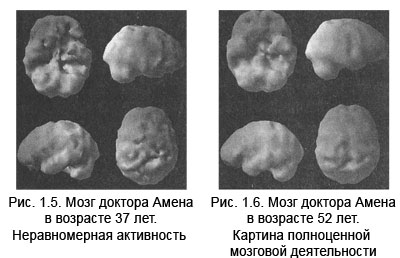
Ten principles for changing the brain and body
1. Your brain is involved in everything you do.
2. When the brain works correctly, the body looks better and feels better. When your brain is malfunctioning, you have problems with your appearance and well-being.
3. The brain is the most complex organ. Respect him.
4. The brain is very soft and is not accidentally placed in a hard skull. Take care of him.
5. The greater your brain reserve, the healthier you are. The smaller the reserve, the more vulnerable you are.
6. Different parts of the brain are responsible for different types of behavior. By understanding your brain, you can optimize it.
7. Many things harm the brain and make it difficult for you to improve your body. But there are many factors that help the brain and simplify the task of acquiring and maintaining a body. Learn to distinguish them.
8. Brain imaging can help you understand how to improve your brain and body health.
9. Not every recipe suits everyone: we are all unique, and you need to understand how your particular brain functions.
10. Yes, it is possible to change your brain and your body!
While studying other people's scans, I developed brain envy and wanted mine to improve. As I've been collecting material about brain health, I've made it a point to do what I teach you and what I've been telling patients for years. By doing this, not only did I finally get good pictures of my brain. I feel energetic, I look healthier than before, I have lost weight, my arthritis is gone, and my skin looks healthier.
In this chapter you will find ten basic principles. They explain why it is important to love and nurture your brain to achieve a healthy body. We use these principles in our work at Amen Clinics and help thousands of people.
Principle 1: Your Brain Is Involved in Everything You Do
The brain controls everything you do, feel and think. When you look in the mirror, you need to thank your brain for what you see. It is the brain that decides whether you will have a slender and toned waist or a belly hanging over your belt. Brain plays key role whether your skin is fresh or wrinkled. Your brain determines whether you wake up rested or tired. In the morning at breakfast, it is the brain that chooses whether you will finish the pizza left over from the evening or eat low-fat yogurt with fruit. The brain determines whether you go to the gym or stay at the computer chatting online. The brain decides whether you light a cigarette or drink a couple of cups of strong coffee. Every moment of brain function is connected to what you think, feel, eat, your physical activity and even how you have sex.
Brain control is the key to well-being and health. Will you live long life, whether an illness will undermine your strength or a terrible disease will end your life untimely - your brain is at the center of all these events.
Researchers from Cambridge in England found that people who take right decisions, shorten their life by 14 years.
People aged 60 years who drink heavily, smoke, are physically inactive, and have a poor diet have the same risks as people 74 years old who lead a healthy lifestyle. This means that the decisions your brain makes can steal years from your life or add them.
Step to action
Remember: the brain is involved in everything you do, every decision, every bite of food, every cigarette smoked, every anxious thought, missed workout, alcoholic drink, and so on.
Principle 2: When your brain works well, your body looks better. If brain function is difficult, problems arise with appearance and well-being
With a healthy brain, it is not difficult to stay in great shape. When your brain activity is optimal, you are more likely to eat a healthy diet, exercise, and exercise. correct image life. And this lifestyle again helps to improve the body and acquire a more youthful appearance, improve immunity and say goodbye to chronic back pain and migraines.
On the other hand, an upset brain leads to problems with the body. Overweight, wrinkles, chronic pain and illness are related to the way the brain works. When your brain isn't functioning at its best, you choose junk food, skip the gym, and indulge in unhealthy habits.
Let's say Jack is an engineer, 52 years old, divorced, his height was 175 cm, and his weight was 125 kg. He tried diets, but was unable to stick to them. Jack got up every morning with the intention of eating healthy, but he never managed to plan meals or stock the refrigerator. When it was almost time for lunch, he felt like he was dying of hunger, and he went to the first fast food restaurant he came across, where he ordered a cheeseburger and fries. Returning home from work, he stared at the empty refrigerator and called the pizza delivery company to order dinner.
Megan, who had three children, a demanding job and a troubled marriage, looked older than her 43 years. She would like to look better, but creams and lotions from the store did not help. She rarely managed to sleep more than a few hours a night. Every time she felt exhausted or depressed, she reached for a cigarette or a glass of wine (or even 2-3 glasses, if not a whole bottle). This relieved her condition for a while.
Sarah, 28 years old, dreamed of improving her figure. Although she was not obese, she wanted to make her 68 kg (with a height of 165 cm) fit and elastic. She knew that exercise would help her achieve her goal. But she lacked the energy and motivation to go to the gym. In addition, Sarah was anxious and nervous, constantly thinking about problems.
For years, Jack, Megan and Sarah believed that their problem was a lack of willpower and laziness, but this is not entirely true. Their inability to change their body was due to the way their brains functioned.
Jack's difficulty with planning was explained weak activity of the frontal lobes. This part of the brain is responsible for planning, goal setting, forecasting, impulse control and determination. If the frontal cortex is not functioning properly, it is difficult to achieve success.
Megan's smoking and addiction to alcohol to relieve emotional stress may signal increased activity of the limbic system of the brain. This subcortical region deep in the brain is responsible for emotions and mood. With reduced activity of the limbic system, people tend to have a positive, optimistic state of mind. Excessive activity of the limbic system leads to negativity, depression, sadness and can encourage the use of nicotine, alcohol and drugs.
Sarah's energy is spent on anxiety and worry, which may mean problem with the so-called basal ganglia. They are located in the central part of the brain and are involved in the integration of feelings and thoughts, as well as motivation. With increased activity of the basal ganglia, people spend energy worrying and are unable to take active action.
The example of Jack, Megan and Sarah shows that the brain has a powerful influence on behavior and the state of the body. The brain helps improve the body, but it can also complicate this task.
Step to action
If you find it difficult to stick to a diet or exercise plan, if you have chronic pain, if you lack energy, then you should improve your brain health.
Principle 3. The brain is the most complex organ. Respect him
The brain is the most complex and amazing organ you can imagine. It weighs only about one and a half kilograms, but at the same time it works more powerfully than the most sophisticated supercomputer. The brain makes up only 2% of the body's weight, but consumes about a quarter of the calories absorbed, a quarter of the total blood flow and a fifth of the oxygen inhaled. It is estimated that the brain contains more than 100 million nerve cells - about as many as the stars in the Milky Way. Each cell is connected to other thousands of individual connections. A particle of the brain the size of a grain of sand contains a hundred thousand nerve cells and a million connections between them. Information in the brain is transmitted at speeds of up to 400 km per hour - faster than racing cars (unless, of course, you have been drinking: in a state alcohol intoxication reactions slow down greatly).
If you do a whole-body SPECT scan, the brain appears glowing, but the rest of the body appears ghostly in comparison. The brain is the representation of personality: it makes you who you are.
Principle 4: The brain is very soft and is placed in a hard skull for a reason. Take care of him
Many people think that the brain is hard and rubber-like in density. It's actually very gentle. The brain is 80% water and has a consistency similar to soft butter, somewhere between raw egg whites and marmalade. To protect the brain, nature placed it IN a hard skull filled with fluid. On inside The skull has many edges and bone sutures. Some of these protrusions can damage the soft brain in an accident. The head is not designed to be kicked and hit - as is the case in boxing or martial arts. Head injuries are much more common than people think. Every year, doctors report 2 million traumatic brain injuries, but millions more go unreported. In this case, not only the brain suffers, but the whole body. If you think that violations only occur as a result of such extreme incidents as falling from a roof or smashing the windshield of a car with your forehead in an accident, then you are mistaken. It is not only severe traumatic brain injuries that have serious consequences. Having studied 55 thousand brain images, I realized that even moderate damage can significantly ruin a person’s life, well-being and appearance. Often people don't even know about these lesions because specialists don't take pictures of their brain function. Research shows that people with mild brain disorders suffer from problems with behavior, emotions, or perception. If thinking is impaired, it is difficult to make the right decisions. Many cases of alcoholism and drug addiction are associated with brain disorders, as well as health complications, deterioration in appearance and social status. Protect your brain.
Step to action
Look after your brain and body and protect your brain from injury. Don't head the ball when playing soccer, and don't ride a bike, snowboard, or skateboard without a well-fitting helmet.
Principle 5: The greater your brain reserve, the healthier you are. A small reserve makes you more vulnerable
Remember your friends, family and acquaintances. Some of them, finding themselves in a difficult situation, “break down”, buy candy, nervously light a cigarette, seek solace in alcohol or drugs, but others, in the same conditions, do not deviate from healthy image life. Have you ever wondered why? I was wondering. Observing patients, I noticed that difficult life events (loss of loved ones, dismissal, divorce) in some people lead to depression, weight changes, reluctance to move, acquisition of bad habits, but other people do not experience anything like this. Comparing brain scans different people For almost 20 years, I have come to the conclusion that everything is explained by brain reserves. In my opinion, brain reserve is a “safety cushion” of healthy brain functions that are activated when stressful situations or injuries. The larger your reserve, the better you can cope with unexpected changes and troubles. The smaller it is, the more difficult it is for you to survive hard times and the more likely you are to resort to sweets or alcohol to cope with difficulties.
Mary and Katie are identical twins. They have exactly the same set of genes, they grew up in the same family and in the same conditions, but they look (and feel) completely different. Mary is fit happy with life journalist, is a long-term happy marriage and has three excellent children. Katie struggled through school and is overweight, " bad character“, depression often occurs, she often changes jobs and men. These sisters have nothing in common.
I did a brain function scan on both of them and found out that Mary has a healthy brain (Figure 1.7), and Katie has obvious signs disturbances in the functioning of the cortex of the frontal and temporal lobes (Fig. 1. 8). At first, when I interviewed the sisters, Katie couldn't remember if she had a head injury. But Mary recalled: when the girls were 10 years old, Katie fell from the top bunk of their bunk bed, hurt her head, and even had to be taken to the hospital. That damage likely left Katie with less brain reserve, making her less resilient to stress than her sister.
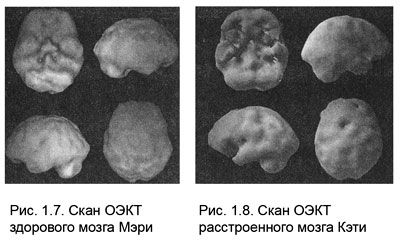
Theoretically, we all have roughly the same brain reserve, and it is huge. But over the course of a lifetime, many factors can increase or decrease it. For example, if your mother smoked marijuana and drank Jack Daniels whiskey during pregnancy, she likely reduced your brain reserve. If you fell off a roof as a teenager, you were a victim. domestic violence, experimented with drugs and alcohol, then, probably, they themselves reduced their reserve. In general, any behavior that harms brain health also reduces its resource.
On the other hand, if your mother adhered to proper nutrition, took a multivitamin and meditated, it may have increased your brain power. Its maintenance is also facilitated by growing up in loving family, interest in learning. Sufficient brain reserve creates resilience and helps to cope with unexpected turns of life without the help of sweets, alcohol and drugs.
Principle 6. Special areas of the brain are responsible for certain types of behavior. By understanding your brain, you can optimize its functioning
We present an overview extra course on the brain systems on which your behavior and body condition depend.
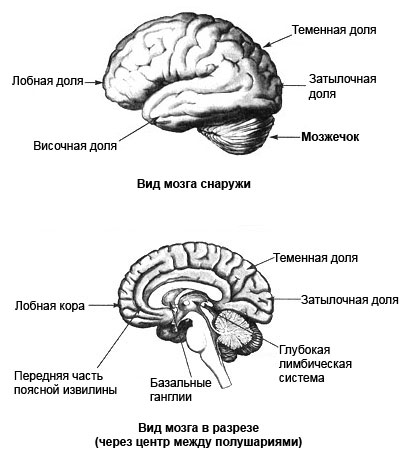
Frontal lobe cortex (prefrontal cortex). This CEO brain The frontal cortex is located in the front third of the brain and acts as the manager of the brain and body. She is in charge of attention, judgment, planning, impulse control, focus, and empathy for another person. Reduced activity in the frontal cortex may be associated with instability of attention, impulsivity, lack of clarity of goals and the habit of procrastination. Alcohol reduces the activity of the frontal cortex, which is why people “do stupid things” when they drink.
Step to action
Improve your brain reserves by adopting a brain-healthy lifestyle.
Anterior cingulate cortex- it can be compared to a car gear shift. The anterior (or frontal) part of the cingulate cortex runs through the deep portions of the frontal lobes and allows people to shift attention, be psychologically flexible, adapt to change, and change when necessary. If this area is too active, the person becomes fixated on negative thoughts and actions; worries a lot, feels dissatisfied, always argues. In addition, this condition makes him dependent or leads to compulsive (obsessive) behavior. Excessive activity in the anterior cingulate cortex is associated with eating disorders (eg, anorexia).
Limbic system (visceral brain). It lies deep in the brain and is responsible for a person’s emotional tone. In people who behave more positively and optimistically, this area is moderately active. And excessive activity of the limbic system is associated with a negative outlook on life, decreased motivation, energy, self-esteem, increased feelings of guilt and helplessness. Disturbances of the deep limbic system are associated with mood disorders.
Basal ganglia. The basal ganglia surround the limbic system and are involved in coordinating our thoughts, feelings and movements. This part of the brain is also involved in setting anxiety levels. For people suffering from anxiety and physical symptoms of stress (this includes headache, abdominal pain, muscle tension), high activity of the basal ganglia is noted. When the activity of the basal ganglia is low, insufficient motivation is observed. This area is also involved in experiencing feelings of pleasure and euphoria. And the basal ganglia are involved in the effects of cocaine. According to former employee According to the American Food and Drug Commission, Dr. David Kessler, author of the book “End Gluttony,” pleasure from cookies, candy and other tasty things is also associated with activation of the subcortical ganglia.
Temporal lobes. The temporal lobes are located behind the eyes in the temple area and are responsible for speech, short-term memory, mood stability and irritability levels. The temporal lobes help us figure out “What is this?” - contribute to the recognition and naming of objects. Temporal lobe dysfunction often leads to memory problems, mood instability, and problems with self-control.
Parietal lobes. The parietal lobes are located in the upper back part of the skull and are involved in processing sensory signals and determining directions. They answer the question “Where?” - help to find things or, for example, to get to the kitchen in the dark. The parietal lobes are among the first to be affected in Alzheimer's disease, so people with the disease often have difficulty with orientation. Parietal lobe dysfunction is also associated with eating disorders and body image distortion (as in anorexics who think they are fat).
Occipital lobes. Located at the back of the brain. This is a representation of vision.
Cerebellum. Located in the lower back of the brain, it is responsible for physical coordination, mental coordination, and speed of information processing. There is a strong connection between the cerebellum and the frontal cortex, which is why many scientists believe that the cerebellum is involved in judgment and impulse control. With problems with the cerebellum, people find it difficult to coordinate movements, learn, and process information slowly. Alcohol directly affects the cerebellum.
By performing motor coordination exercises, you can improve the functioning of the cerebellum and thereby improve the functioning of the frontal lobe cortex, which will help with decision making.
Summary of Brain Systems
Frontal lobe cortex - judgment, forecasting, planning, impulse control.
Anterior cingulate cortex - switching attention.
Deep limbic system - emotional tone, mood, feelings of affection.
Basal ganglia - integration of thoughts, feelings and movements; getting pleasure.
Temporal lobes - memory, mood stability, irritability and restraint, object recognition.
Parietal lobes - processing of sensory information. Sense of direction.
Occipital lobes - vision and processing of visual information.
Cerebellum - coordination of movements, thoughts, speed of information processing and judgment.
Principle 7: Many things harm the brain and make it difficult to improve the body. But many others help the brain and contribute to the creation and maintenance of the desired body
You might be surprised when I start listing the things that harm your brain and get in the way of good health. physical fitness. Here are just a few examples of unwanted behavior that I will talk about later in the book. (This information is so important that it won't hurt to repeat it.)
Physical injuries. Serious injuries, concussions, and even minor injuries have a significant impact on your well-being.
Drugs. Marijuana, cocaine, ecstasy, methamphetamines, heroin and substances used by substance abusers significantly reduce brain function. The brain is affected not only by illicit drugs, but also by many prescription drugs (eg, sleeping pills, tranquilizers, some heart medications, etc.). Drugs and medications can reduce or increase appetite, which leads to weight loss or gain, “pump out” motivation and energy, and worsen the condition of the skin, nails, teeth, and hair. Search www.youtube.com for pictures of people before and after using methamphetamines. These photos will horrify you.
Alcohol. You don't have to be a heavy drinker to damage your brain. Even moderate amounts of alcohol impair brain function. Research shows that the brains of people who drink alcohol every day are smaller in size than those of non-drinkers. And when it comes to the brain, size matters! Alcohol reduces the activity of the frontal cortex, which is responsible for judgment, forecasting and planning. So, after drinking, people make unwise decisions - like driving or eating at a fast food restaurant at three in the morning (even though they have weight problems), or having sex without a condom with a partner they are seeing for the first time in their lives.
Obesity. Fat accumulates toxic substances. The more fatty tissue there is in the body, the worse it is for the brain. Obesity doubles the risk of Alzheimer's disease and has been linked to decreased brain matter.
Hormonal disorders. An imbalance of thyroid hormones, estrogen, progesterone, testosterone, DHEA (dehydroepiandrosterone) or cortisol affects the body and the brain.
Poor nutrition. Every few months, the cells of the body are renewed. The quality of new cells depends on the food you eat, so you really are what you eat. Unhealthy eating leads to disorders of the brain and body. Lack of vitamin D, minerals, and Omega-3 fatty acids harms brain tissue and the body.
Chronic inflammation in the body. Chronic inflammation impairs blood flow to the brain and heart and is thought to be the cause of many diseases, including diabetes, heart disease, obesity and Alzheimer's disease.
Anemia. Blood is important because it carries oxygen, sugar, vitamins and nutrients to the brain and takes away toxins from it. Anything that impairs the blood supply to an organ (nicotine, caffeine, lack of physical activity) ages it prematurely. This is especially true for the brain.
Chronic stress. A troubled marriage, a responsible job, and financial difficulties cause chronic stress. If you constantly feel stressed, your brain tells your body to produce more of the stress hormone cortisol. At elevated levels cortisol increases appetite, cravings for sweets, increases sebum production (increasing the tendency to acne), increases muscle tension (leading to chronic pain), blood pressure and the risk of various heart diseases.
Sleep disorders. Sleeping less than 6 hours a night reduces brain function and causes the brain to release hormones that increase appetite and the desire to eat sweets. People who don't get enough sleep often eat more calories than they need and gain weight. In addition, lack of sleep prematurely ages the skin and leaves dark circles under the eyes.
Smoking. Smoking impairs blood flow to the brain and all organs of the body, including the skin. A smoker can be easily identified by the condition of his skin - it looks older than his biological age. Believe me, a smoker's brain looks the same. Smoking leads to many serious problems with the brain and body.
Excess caffeine. Too many servings of coffee, tea, energy drinks with caffeine, they impair blood flow to the brain, dehydrate the brain, body and skin, and trick the brain into thinking it is okay to stay awake. It is harmful to the body and brain.
TV hobby. Excessive watching of television harms both the brain and body. In children, TV increases attention deficit disorder; in adults, it increases the risk of developing Alzheimer's disease. Watching TV for more than two hours daily also increases the risk of obesity.
Violent video games. Violent video games increase aggression and impair learning. We've seen in brain imaging that this type of gaming affects the same area of the brain as cocaine, which is why children and adults become hooked on video games like drugs. More than two hours of video games a day adds to the risk of obesity.
Dehydration. Your body is 70% water and your brain is 80% water. If you don't drink enough, you worsen brain function and skin quality (more wrinkles appear).
Lack of physical activity. Lack of activity impairs blood circulation in the brain, body and genitals. It's well proven that lack of exercise is bad for your body weight and overall health and can reduce your sex drive.
Negative thinking. We've done research that shows that focusing on things you don't like reduces brain activity, increases heart rate, increases blood pressure, and negatively affects many systems in the body. Negative thinking sabotages your attempts to lose weight, start exercising, or quit smoking.
Excessive passion for communicating on the Internet and via SMS. Neuroscientists have proven that “electronic addiction” leads to deterioration of attention and can cause difficulties in personal communication. In addition, it distracts from training, promotes weight gain and generally worsens health.
I developed a course for high school students on hands-on brain care to teach teens to love and care for the brain. It has been implemented in forty states and seven countries. Every time some “witty” student asks: “How can you enjoy life if you can’t do anything?” Our answer is simple: who gets more pleasure from life, a person with a well-functioning brain or a person with a disordered one? It doesn't matter how old you are, if your brain is healthy, you will enjoy life. It is easier for a person with a healthy brain to watch what he eats and exercise physical activity, accordingly, he will look good, he has a lot of energy to play golf with potential client or dance with your wife. But a guy with brain disorders may experience impulsive overeating, which will lead to weight gain, type 2 diabetes and decreased enjoyment of life. And which of the two is having more fun?
A woman with a healthy brain sleeps well, wakes up rested and refreshed, which gives her confidence in relationships, and she is attentive at work. And in a woman with reduced brain activity, fatigue accumulates, which worsens her professional results, interferes with career advancement. She also looks exhausted, which lowers her self-esteem, and this has a bad effect on relationships. And which one is having more fun?
I have great news for you! After years of studying brain imaging and treating patients, I have discovered that there are many simple everyday factors that can help enhance brain function. These simple recommendations are the key to a better body. Later in this book you will find many ideas on how to improve brain function. Here are just a few to get you started.
Protect your brain. Both yours and those who are dear to you.
Eat right. The brain needs quality nutrients: proteins, fruits, vegetables, nuts, healthy fats like olive oil. Research shows that your brain works better if you eat 9 servings of fruits and vegetables daily.
Take vitamins, minerals and fish oil every day. Most of us don't get all the nutrients we need from food. I recommend taking a supplement every day, as well as fish oil, which helps reduce inflammation, improve blood circulation in the brain, and fight depression.
Exercise. Exercise rejuvenates the brain. They increase blood circulation, increase the amount of oxygen in the blood, and help fight stress. This is the most The best way help the brain and at the same time improve your figure, mood, recharge your energy, including sexual energy, and improve your health.
Get enough sleep. You need at least 7 hours of sleep for your brain to function optimally, regulate your appetite, and allow your skin to look its best.
Meditate. Meditation activates the deep structures of the brain and helps you make the right decisions.
Relax. Learning to manage stress and calm your body will help your brain function, improve your mood, and lower your blood pressure.
Be grateful. If you focus on what you love, your brain will work better and you will become more coordinated. Every day, write down five things for which you are grateful. You will see a significant positive mood shift within three weeks.
Have more sex. Safe sex, especially sex in a loving, committed relationship, is good medicine for the brain and body, it helps reduce stress, strengthens the immune system, and prolongs life.
Balance your hormones. Hormones such as estrogen and testosterone play a key role in maintaining the health and energy of the brain and body.
Treat mental disorders. There is a relationship between mental disorders and physical illnesses. Treating mental illnesses improves brain function and overall well-being.
In a word, everyday life can both improve and worsen brain function. What will you choose: a healthy brain and a comfortable life or a sick brain and problems with health and affairs? The choice is yours.
Principle 8: Brain Imaging Helps Understand How to Improve Your Brain and Change Your Body for the Better
I have often been able to help couples' relationships. Rob and his wife came to see me because family problems. Like many men, he thought that everything was going fine for them and that his wife just needed to relax and accept the situation. When I looked at his 56-year-old brain (Fig. 1. 10), it seemed to me that the owner was at least 80. I was surprised to ask what he was doing that damaged his brain so much. “Nothing,” he replied. “Really? - I didn’t believe it and asked: “How much do you drink?” - "Not much". As a psychiatrist, I learned that if a patient answers “not very well,” I need to keep asking.
And yet how much?
Three, maybe four glasses a day.
Every day?
Yes, every day. But this doesn’t bother me, I never get drunk.
However, his brain was telling me that “this is getting in the way.” Frightened by the sight of his scan, Rob followed my instructions and gave up alcohol. He also developed “brain envy” and began our brain health program. Four months later I took a follow-up photo, which looked much better. By that time, his relationship with his wife had also changed, and he felt 30 years younger.
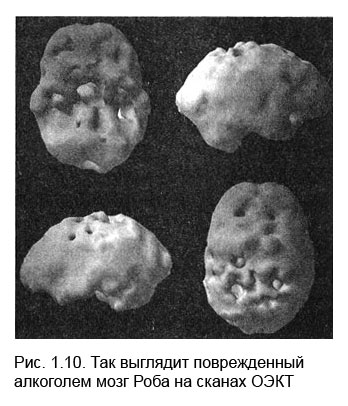
The brain scans helped me understand what Rob's problems were. They also illustrate that if the brain looks old, so does the body.
If you do something that impairs blood circulation in the brain, it also impairs it in the skin, making it dull and wrinkled. The blood circulation of other important organs also suffers (which suppresses their functions), including the blood supply to the genitals (which makes it difficult to have sex and enjoyment).
Brain imaging helps us track problems in individual brain structures. For example, if you have low activity in your frontal cortex, you become more impulsive. High activity in the anterior cingulate cortex makes you more compulsive. Overstimulated basal ganglia promote anxiety and force you to eat to calm down. Excessive activity of the deep limbic system is combined with sadness and again pushes towards food. And the inhibition of cerebellar function reduces the speed of information processing, making it difficult to be organized and plan your life.
The images help ensure that excess weight, depression, anxiety and addictions are not isolated or simple disorders and cannot be treated in the same way. The images help us understand the differences between patients and develop a specific treatment plan. Depending on the individual situation, the brain needs to be either stimulated or calmed. If we don't see how the brain works, how will we know which direction to move.
Does this mean that you too need to run out and get a brain scan to change your body? No! My books have been translated into more than 30 languages, and I realized that not all people have the opportunity to have their brain scanned. That's why I created self-questionnaires to help you find your strengths and weak sides brain Amen Clinics short and long brain questionnaires can be found on our website www. amenclinics.com/cybcyb. These questionnaires are effective and have helped hundreds of thousands of people choose the best treatment. Of course, before doing anything, you should consult your doctor.
Step to action
Remember that a beautiful brain means a beautiful body. If you want a beautiful body, ask yourself, what do you need to first make your brain beautiful?
Principle 9. One recipe does not fit all, each person is unique, and you need to take into account how their brain functions.
Why does a doctor never diagnose chest pain? Because it's a symptom. It is too general and can be caused by many things. For example, grief panic attacks, hyperthyroidism, pneumonia, lung cancer, toxic substance poisoning, heart attack, arrhythmia, fractures and cracks in the ribs, indigestion, gastric reflux esophagitis, gallstones, liver disease, kidney disease and pancreatic cancer. Each of these causes must be treated differently.
Same with the reasons for excess weight. Poor diet, lack of exercise, decreased thyroid function, pituitary tumors, certain types of depression and medications. Excess body weight is sometimes attributed to low brain activity, which causes people to eat impulsively, or overstimulation of certain brain systems, which contributes to increased anxiety. Excess weight may develop due to hyperactivity of the anterior cingulate cortex (emotional eating) or a combination of several problems.
There are many different types obesity. What does chest pain have in common? overweight, skin problems, lack of energy and depression? All of the above are symptoms, not causes. Often therapists and patients view them as separate, independent disorders. Because of this simplistic approach, it is believed that one recommendation will cure each specific disorder.
From the point of view of brain function, this makes no sense, since there are not a lot of varieties of obesity, stress reactions, anxiety and depression. It is important to understand your individual characteristics to correct mood, problems with concentration, normalize body weight and general well-being.
Principle 10: Yes, the brain and body can be changed!
This is one of the most inspiring discoveries in medicine. By using some remedies and changing a few things in your lifestyle, you can improve your brain function and body condition. The answer to the question why you couldn’t force yourself to eat right and exercise all your life, why you quit smoking for years or went through treatment, lies in the way your brain works. Remember Becky, the impulsive, unhealthy woman I mentioned. Due to weak activity in the frontal cortex, she was unable to control her tendency to impulsively overeat. Only after treatment for her brain was Becky able to stick to a healthy diet and lost 40 kg.
I have observed this in my practice more than once. When the work of the frontal lobe cortex improves, the patient becomes more thoughtful, reasonable, consistent and adheres to the health program. The same thing happens when optimizing other areas of the brain. When we calm the anterior cingulate, people feel less anxious, more optimistic, and sleep better, which helps them transform their appearance. Stabilizing the temporal lobes strengthens memory, which helps people stick to their goals. Calming the basal ganglia makes people more relaxed and happier, with fewer headaches and digestive problems. Strengthening the function of the cerebellum helps with learning, maintaining healthy programs and improves performance in sports - serving in cricket or percentage of successful shots in basketball.
Step to action
To get the body of your dreams, you need to believe that you can change your brain.
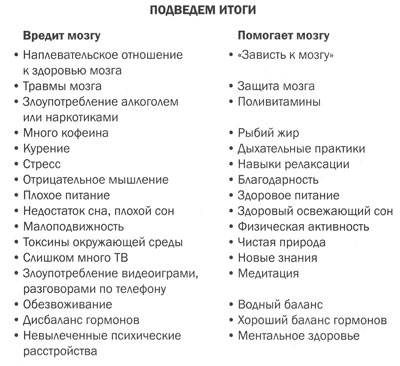
Notes:
More complete official name syndrome - “attention deficit hyperactivity disorder” (ADHD). This diagnosis is often given to children of preschool age. - Approx. ed.
You can also take regular methionine. - Approx. ed.
A conventional American serving of vegetables or fruits corresponds to one medium-sized fruit (tomato, apple, pepper, beet, orange) or a handful of smaller fruits (broccoli, plums, berries). - Approx. ed.
Intelligence is the ability to adapt means to ends. A. Binet
How does our brain work, not from the point of view of physiology, but from the psychology of thought processes? Quite a lot has been written about what the right and left hemisphere brain, a lot of tips and recommendations to stimulate thinking, like these: “Take different routes to work every time,” “Change your working hand: if you are right-handed, use left hand, and vice versa,” “Solve crosswords, play logic games, chess, for example,” etc. True, why all this is not explained, it seems understandable as a matter of course. Knowing how a person thinks, it becomes possible to understand what resources exist to stimulate thinking at each stage of brain function.
Where does mental activity begin? In order to think, we must have “something to think about,” i.e. information. Thinking is, essentially, operating with available information. How does this information come to us? What is responsible for what in the brain
1. Initially, a person perceives everything that he knows at the level of the senses - i.e. all information at this stage is sensory, this is what we see, hear, feel.
This information enters memory, which can be safely considered “the totality of information acquired by the brain and controlling behavior.”
The higher the concentration of attention on sensory sensations, the more information enters memory. As a rule, attentiveness increases when we are interested in something - for example, everything new. That is why it is recommended to go to work or to the store on a new, unfamiliar route. IN otherwise There is a high risk of living on autopilot when the brain goes into hibernation or only works at its 5%.
The sensory type of information is stored in memory for a very short time, because there is a lot of such information, and the brain somehow needs to separate the more priority from the less important. In order for sensory information to move into long-term memory, it is necessary:
2. So that the various properties of objects form a common picture, an image. For example, a cat is a small, meowing, furry pet. Thus, concepts and abstract images are formed, which the human brain subsequently operates with.
Concepts are abbreviations in which we cover, in accordance with their general properties, many different sensory things. F. Engels
That is why, in order to remember a heard phone number or the name of a new acquaintance, it is necessary to present auditory and visual information figuratively - somehow connect it with the person’s appearance, the circumstances of the meeting, etc.
Classification is a meaningful order of things, phenomena, dividing them into varieties according to some important characteristics.
“Classification is a meaningful order of things, phenomena, dividing them into varieties according to some important characteristics.” The most valuable are classifications based on knowledge of the laws of connection between species, the transition from one species to another in the process of development (for example, the classification chemical elements, created by Mendeleev).
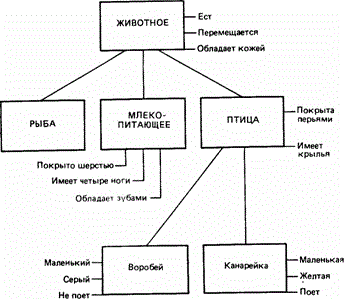
As soon as concepts have been formed, they can begin to be divided into means and ends - a very significant point in improving mental activity. Moreover, depending on the situation, different concepts can be either means or goals.
4. Having certain concepts in stock and endowing them with personal meaning, a person begins to build logical mental operations.
Logical or abstract mental operations that naturally occur in an adult’s brain, preceded by specific operations - this is when children assemble and disassemble toys, and not only toys :), manipulate specific objects in every possible way.
First we need to carry out these operations in practice and only then can we move on to “theory”, otherwise how will we be convinced that this is the case?..
With the help of mental operations, one penetrates deep into the goal problem, studies the properties of objects (not necessarily in front of the eyes) that make up this problem (not necessarily in front of the eyes), and finds a solution to the problem (first of all in the mind and only then implemented in practice) .
5. A judgment reflects connections between objects and phenomena, affirms something or denies it.
How more connections established between different objects, the greater the likelihood that the correct solution to the problem will be found from the many available ones. That is why during a brainstorming session it is recommended to put forward even fantastic, impossible ways to solve a problem, like “Suddenly a wizard will fly in in a blue helicopter and show a movie for free.”
5.1 Judgments do not necessarily contain comparisons, although this happens quite often. If someone says, “I am selfish,” you can ask, “Who said that?” If he answers: “I” or some authoritative person, then you can express doubt: “By what measure did you (he) decide that you are an egoist?”
5.2 Judgments include analysis, which means dividing (breaking) an object into its constituent parts or properties.
And also synthesis is the process of connecting or combining previously separate properties or concepts into a whole or set. Synthesis is inseparable from analysis and they are usually carried out simultaneously.
6. Based on several judgments, a certain conclusion is drawn - an inference. An example of an inference: A person, waking up in the morning, sees puddles on the street and comes to the conclusion that there was heavy rain at night.
Inferences can be inductive, deductive, or by analogy.
6.1 Inductive inference is an inference from the individual (particular) to the general. From judgments about several isolated cases or about groups, a person makes general conclusion. For example, a teacher, looking through the annual assessments of each student’s knowledge, did not see a single “D”. From these facts (special cases) he draws a general conclusion: the whole class is doing well.
6.2 Reasoning in which the thought moves in the opposite direction is called deduction, and the conclusion is called deductive. Deduction is the conclusion of a particular case from general position, the transition of thought from the general to the less general, to the particular or individual. For example: in class 9b all students are doing well. Sidorov is in grade 9b, therefore he is a successful student. Deduction allows people to predict the course of events and discover new facts based on the revealed pattern.
Pitfalls of generalization: There is a danger of not seeing individual trees in the forest if different parts of the experience are indiscriminately lumped together under one name. For example, judging all representatives of a certain nationality based on the qualities of individual individuals. Being overly “carried away” by generalization, a person will see and hear only what he expects to see and hear.
6.3 Inference by analogy is an inference from particular to particular. The essence of inference by analogy is that, based on the similarity of two objects in some respects, a conclusion is drawn about the similarity of these objects in other respects. The conclusion that there is life on Mars was made by analogy between Mars and the Earth: Mars, like the Earth, is a planet, surrounded by an atmosphere, has several seasons and times of day, etc. Based on conclusions by analogy, hypotheses are created.
From the point of view of formal logic, the structure of an inference looks something like this:
- All liquids are elastic.
- Mercury is a liquid.
- Mercury is elastic. (conclusion)
But(!) inference is different from inference:
- All caterpillars eat lettuce.
- I'm eating salad.
- I'm a caterpillar :)
Thus, the adaptation of means to ends, the adaptation of man to environment carried out in two ways:
1) Assimilation, in which a person tries to adapt a new situation to the existing structure of information.
2) Accommodation (J. Piaget’s term), in which, on the contrary, previous knowledge is transformed, remade in order to adapt it to a new situation.
Structure of the thought process of solving a problem:
- Motivation (desire to solve a problem).
- Analysis of the problem (highlighting “what is given”, “what needs to be achieved”, what missing or redundant data are available, etc.).
- Finding a solution: using known algorithms, based on a combination of links from various algorithms, the empirical method of trial and error, using logical mental operations (see above), etc.
- Logical justification for the found solution idea, logical proof of the correctness of the solution.
- Implementation of the solution in practice.
- Checking the solution found.
- Correction (if necessary, return to point No. 2).
To summarize, resources for improving brain function, taking into account the stages of the thought process, would be:
- Attentiveness in the assimilation of sensory information.
- Competent formation of concepts taking into account their properties, construction of classifications (at least in the mind; see above for an example of classification).
- Understanding the reasons for the emergence of the personal meaning of a particular concept.
- Expanding connections between concepts, even if at first glance they are not related.
- Critical attitude to judgments.
- Checking the correctness of inferences and conclusions.
- Step-by-step solution to the problem, if necessary (see structure of thought processes)
Mental activity is realized both at the level of consciousness and at the level of the unconscious - for example, Archimedes’ “eureka” and the periodic table refer to the results of the second type of thinking.
The following two picture tests will allow you to better understand how you collect information from the world around you and how you operate with it.
Test No. 1. Practical and Logician.
In front of you is a chain of ovals. Based on this detail, you need to recreate the whole picture, create a whole from one fragment. What you draw and how you complement this drawing depends only on you.
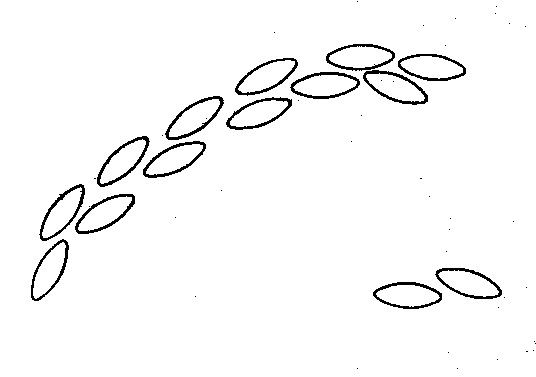
Test No. 2 Sensory and Intuitive.
Instructions. In front of you random dial figures, some kind of composition. Using one, two, or more shapes (as many as you need to complete the task), draw a person.
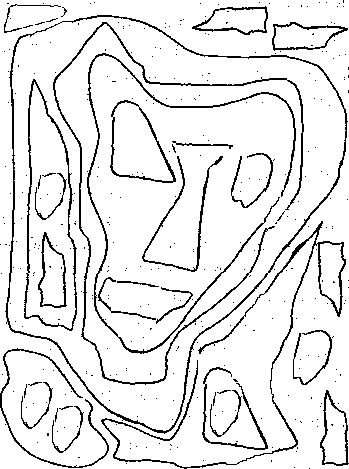
Test keys are given in the article “ ”
The reason for writing this article was the publication of material by American neurologists on the topic of measuring the memory capacity of the human brain, and presented on GeekTimes the day before.
In the prepared material I will try to explain the mechanisms, features, functionality, structural interactions and features in the functioning of memory. Also, why is it impossible to draw analogies with computers in the work of the brain and carry out calculations in machine language units. The article uses materials taken from the works of people who devoted their lives to hard work in the study of cytoarchitectonics and morphogenetics, confirmed in practice and having results in evidence-based medicine. In particular, the data of S.V. Savelyev is used. scientist, evolutionist, paleoneurologist, doctor of biological sciences, professor, head of the laboratory of development of the nervous system at the Institute of Human Morphology of the Russian Academy of Sciences.
Before proceeding to consider the issue and the problem as a whole, we will formulate basic ideas about the brain and make a number of explanations that allow us to fully appreciate the presented point of view.
The first thing you should know: the human brain is the most variable organ, it differs between men and women, racial and ethnic groups, variability is both quantitative (brain mass) and qualitative (organization of sulci and convolutions) in nature, this difference has different variations turns out to be more than double.
Second: the brain is the most energy-consuming organ in the human body. Weighing 1/50 of your body weight, it consumes 9% of your entire body's energy when you're at rest, like when you're lying on the couch, and 25% of your entire body's energy when you're actively thinking, a huge expense.
Third: due to high energy consumption, the brain is cunning and selective, any energy-dependent process is disadvantageous for the body, this means that without extreme biological necessity such a process will not be supported and the brain tries to save the body’s resources by any means.
Here are, perhaps, three main points from far from full list features of the brain that will be needed when analyzing the mechanisms and processes of human memory.
What is memory? Memory is a function of nerve cells. Memory does not have a separate, passive energy Not costly localization, which is a favorite topic of physiologists and psychologists, supporters of the idea of intangible forms of memory, which is refuted by sad experience clinical death, when the brain stops receiving the necessary blood supply and approximately 6 minutes after clinical death, irreversible processes begin and memories disappear irrevocably. If memory had energy Not dependent source, it could be restored, but this does not happen, which means the memory is dynamic and constant energy costs for its maintenance.
It is important to know that the neurons that determine human memory are located primarily in the neocortox. The neocortex contains about 11 billion. neurons and many times more glia. (Glia are a type of cell in the nervous system. Glia are the environment for neurons; glial cells serve as a supporting and protective apparatus for neurons. The metabolism of glial cells is closely related to the metabolism of the neurons that they surround.
Neocortex:
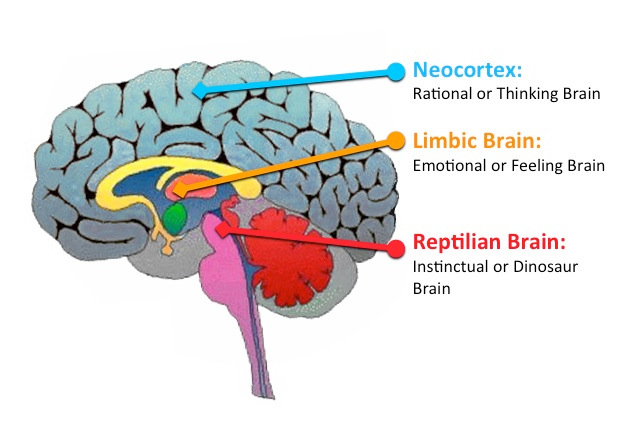
Glia, neuron connections:
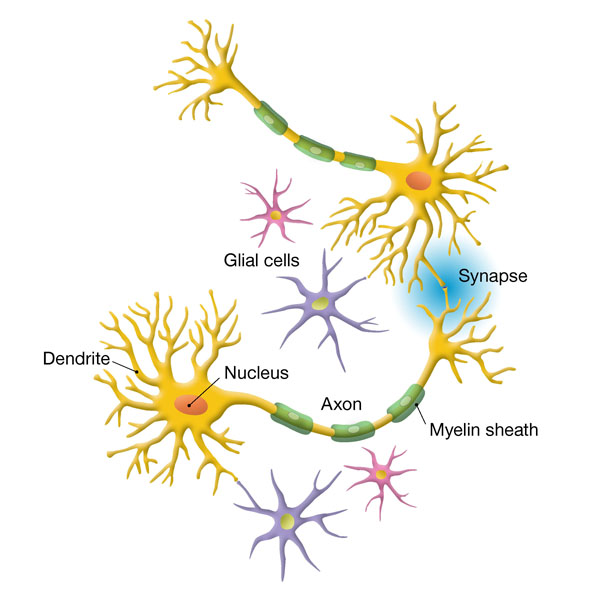
It is well known that information is stored in memory different time, there are such concepts as long-term and short-term memory. Events and phenomena are quickly forgotten if they are not updated and repeated, which is another confirmation of the dynamism of memory. Information is retained in a certain way, but in the absence of demand it disappears.
As mentioned earlier, memory is an energy-dependent process. No energy - no memory. A consequence of the energy dependence of memory is the instability of its content. Memories of past events are falsified in time to the point of complete inadequacy. Memory does not count time, but it is replaced by the speed of forgetting. The memory of any event decreases in inverse proportion to time. In an hour, ½ of everything in memory is forgotten, in a day – 2/3, in a month – 4/5.
Let us consider the principles of memory operation, based on the biological expediency of the results of its work. The physical components of memory consist of neural pathways connecting one or more cells. They include zones of gradual and active signal conduction, various systems synapses and cell bodies of neurons. Let's imagine an event or phenomenon. The man was faced with a new, but quite important situation. Through certain sensory connections and sense organs, a person received various information, the analysis of the event ended with a decision. At the same time, the person is satisfied with the result. There is residual excitation left in the nervous system - the movement of signals through the networks that were used to solve the problem. These are the so-called “old chains” that existed before the situation with the need to remember information. Maintaining the circulation of different information signals within one structural chain is extremely energy-consuming. Because keeping in mind new information usually difficult. During repetitions or similar situations, new synaptic connections between cells can be formed and then the information received will be remembered for a long time. Thus, memorization is the preservation of residual activity of neurons in a brain region.
Brain memory is a forced compensatory reaction of the nervous system. Any information goes into temporary storage. Maintaining the stability of short-term memory and the perception of signals from the outside is extremely energetically expensive; new exciting signals arrive to the same cells and transmission errors accumulate and energy resources are over-expended. However, the situation is not as bad as it looks. The nervous system has long-term memory. Often it transforms reality in such a way that it makes the original objects unrecognizable. The degree of modification of an object stored in memory depends on the storage time. Memory preserves memories, but changes them as the owner wants. Long-term memory is based on simple and random processes. The fact is that neurons form and destroy their connections throughout their lives. Synapses are constantly being formed and destroyed. Quite rough data suggest that this process of spontaneous formation of one neuronal synapse can occur in mammals approximately 3-4 times every 2-5 days. Branching of collaterals containing hundreds of different synapses occurs somewhat less frequently. A new polysynaptic collateral is formed in 40-45 days. Since these processes occur in every neuron, it is quite possible to estimate the daily long-term memory capacity for any of the animals. It can be expected that in the human cerebral cortex about 800 million new connections between cells will be formed every day and approximately the same number will be destroyed. Long-term memory is the inclusion in the newly formed network of areas with completely unused, newly formed contacts between cells. The more new synaptic contacts are involved in the primary (short-term) memory network, the more chances this network has to survive for a long time.
Remembering and forgetting information. Short-term memory is formed on the basis of existing connections. Its appearance is indicated by orange arrows in fragment b. Signals containing both old (purple arrows) and new (orange arrows) information circulate along the same paths. This leads to extremely costly and short-term storage of new information based on old connections. If it is not important, then the energy costs for its maintenance are reduced and forgetting occurs. When storing “short-term” but now necessary information, new physical connections are formed between cells along fragments a-b-c. This leads to long-term memory based on the use of newly formed connections (yellow arrows). If information remains unclaimed for a long time, it is replaced by other information. In this case, connections may be interrupted and forgetting occurs. fragments b-b-a or in-a (blue arrows)."
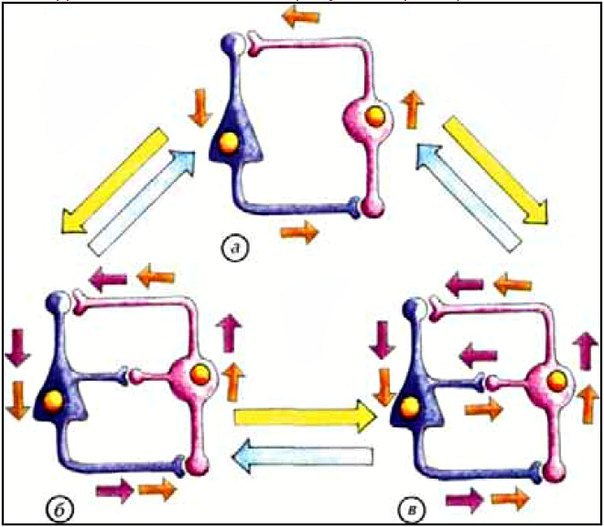
From the above, it is clear that the brain is a dynamic structure, is constantly being rebuilt and has certain physiological limits, and the brain is also an excessively energy-consuming organ. The brain is not physiological, but morphogenetic, therefore its activities are incorrect and incorrect to measure in systems used and applied in information technology. Due to individual variability of the brain, it is not possible to draw any conclusions generalizing the various functional indicators of the human brain. Mathematical methods are also not applicable in calculating the structural interaction in the work of the human brain, due to the constant change, interaction and restructuring of nerve cells and connections between them, which in turn brings to the point of absurdity the work of American scientists in studying the memory capacity of the human brain.
The brain is most complex organized organ person. After all, it is responsible for the work of all organs, as well as for many complex processes, such as memory, thinking, feelings, speech. In addition, the human brain is also responsible for consciousness. Let's figure out how the brain works.
The brain is the central organ of the nervous system. It is located in the skull, which protects it from damage and exposure to temperature. In an adult, the brain weighs on average 1.4 kg, and in appearance it looks like a large Walnut. The brain consists of gray and white matter, which consists of nerve cells and nerve fibers. Neurons send and receive electrical signals to all organs of the body through a network of nerve endings. The brain and spinal cord, as well as nerve endings throughout the body, make up nervous system person.
Anatomically, the brain consists of three main parts - the brain stem, hemispheres, and cerebellum. In addition, the brain contains endocrine glands such as the thalamus and hypothalamus. Let's look at the functions and structure of each part to better understand how the human brain works.
Hemispheres of the brain
The hemispheres of the brain are its largest part. They make up approximately 90% of the total volume. The hemispheres divide the brain into two approximately equal parts, connected by a dense bridge - corpus callosum. The structure of the hemispheres consists of gray and white matter. Gray matter makes up the surface of the brain and is made up of complex nerve cells that generate electrical impulses. A white matter, which is located inside the hemispheres, consists of nerve fibers. They transmit signals throughout the body.
The complex structure of the cerebral hemispheres allows them to be responsible for many functions of the human body, most of which relate to higher mental activity, for example, memory, thinking, etc. Physiologically, this represents a clear division into zones that are not noticeable from the outside. Each zone is responsible for certain human functions. You can learn more about what the hemispheres are responsible for in one of our articles - "".
Cerebellum
The cerebellum is located at the back of the brain, just below the back of the head. The cerebellum receives motor signals from the hemispheres, after which it sorts them, concretizes them and sends signals to specific muscles or tendons. The cerebellum is responsible for movements of both individual muscles and the overall smoothness and coordination of human movements.
Brain stem
The brain stem is at the base and connects the brain to the spinal cord. The brain stem is responsible for vital automatic processes such as heartbeat, digestion, body temperature, breathing, etc.
Hypothalamus and thalamus
The hypothalamus is an endocrine gland that is responsible for many complex functions and manifestations of a person. For example, it controls hunger, sleep, thirst, as well as strong emotions - anger, joy, fear. The hypothalamus is located at the top of the brain stem.
The thalamus, in turn, is the coordinator of all human glands. No larger than a pea, the thalamus regulates the release of all hormones in the body.
How the brain works: an internal process
At first glance, the work of the brain seems extremely simple. Nerve impulses, enter one hemisphere, where they are read and processed. Then, they are sent to the desired part of the body. By the way, the signals coming from right side bodies are sent to the left hemisphere.
In general, we can say that the brain is the organ that controls all processes of the body. By using neural network he directs the body like a conductor, indicating what needs to be done by which organ.
The human neural network consists of nerve cells – neurons. In their structure, they have several inputs - dendrites, and one output - an axon. We can say that a neuron receives many signals, sums them up and produces one common output signal, which is transmitted further. Human neurons have the ability to “learn” - over the course of life, they can change their threshold amount of signals. When neurons increase the sum of signals, a person learns, and when the sum of signals decreases, a person forgets or loses a skill.
Now you know how the brain works. The brain is believed to be many times more powerful than any computer ever created. IN human brain about 100 billion nerve cells that constantly die and appear, and also tend to develop.
In order for the brain to constantly develop, it needs to work. Practical advice for this you can find in one of our articles - "
Research and books about our brain can't explain it functional features. Previously, experts pointed out that the brain uses only 5-10% of its capabilities, but people with extraordinary abilities control it 100%. However, the first fact has already been refuted. All parts of our brain are constantly active, even during sleep, so it would be incorrect to talk about 10%. The second option has not yet been studied and is not explained in any way.
Despite the lack of information about this organ, many discoveries have been made over the past 10 years, however, this is not enough to fully understand its full functionality and what the human brain is capable of.
Nature also intended to provide the brain with all the necessary protective functions. It is the central organ, without which life is impossible.
- The substances of the brain are located in the cranium, which provides their protection
- Hair helps protect him from the cold
- The choroid plexuses that envelop the organ provide its nutrition
- The liquid acts as a layer and significantly softens possible mechanical shock
A central authority controls functions and activities. We owe to him the ability for linguistic speech, visual and auditory functionality, touch, logical thinking. The human brain works in two hemispheres. Left, responsible for logic, the ability to think technically. The right one provides visualization and promotes creative expression.
If you force both hemispheres to function simultaneously, the ability to memorize increases several times. Each part of the brain is responsible for specific functions. The volume does not exceed 2% of body weight.
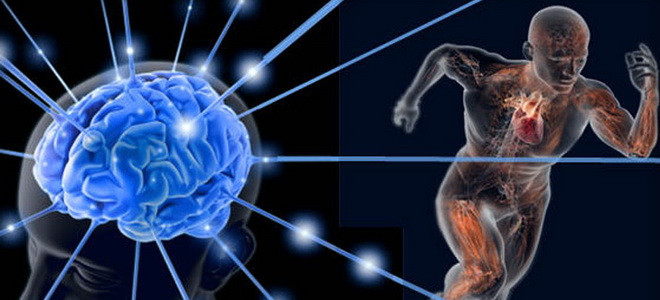
Development
It is believed that the capabilities of a person’s brain and the type of his thinking are set in childhood by upbringing, which creates a certain foundation and intellectual direction and does not change with age.
This is a wrong belief, since every person is capable of developing brain capabilities and increasing intelligence. Abilities are limited by the degree of awareness and willpower. Some individuals have a high propensity to decide logical problems, others cope by significantly simplifying it. It is important that both our hemispheres develop equally.
For this purpose, for the brain and stimulation of the expansion of abilities, the following measures should be taken:
- Constantly solve logical and creative problems. The brain must be loaded for activity in both hemispheres
- Regular change of activity. It is necessary to alternate work/break/full rest. It is not recommended to engage in one type of activity for more than 6-8 years. In the process of stagnation and solving monotonous problems, the brain slows down in development
- Lead active image life, occupy yourself more often with mental and physical exercise. Exercise stress in a positive way affects mental development. To do this, just do simple exercises every day.
- Try to change your environment more often
- Eat right and give up bad habits

Superpowers of the human brain
There are people who have quite amazing brain abilities that are inaccessible to the average person.
Research into stimulating the development of superpowers has so far been unsuccessful, and their nature still remains a mystery. Hidden capabilities of the human brain:
- The ability to come out of almost any critical situation as a winner
- Developed intuition that often makes the right decisions
However, this is in to a greater extent mental abilities of a person, which may have been transmitted genetically or due to early self-education.
Beyond capabilities:
- Abnormal counting and reading speed
- Reading and Memorizing a Book Verbatim
- The opportunity to learn an entire language in just a week
- Photographic memory
- Clairvoyance
Wolfgang Messing had unique abilities - he read thoughts. These data were never refuted at the time of his life. It is believed that yogis have some superhuman qualities, but they are trained in this, but by innate nature.
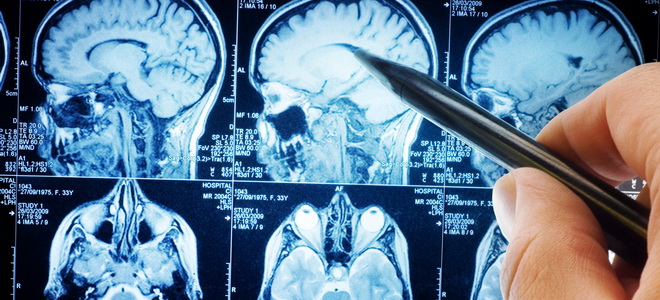
Extraordinary states
Brain studies indicate quite specific abnormalities in the development of the organ. Experts identify cases that are quite difficult to explain.
Amazing anomalies are known:
"The Man Living with Half a Brain"
A reported incident that occurred with Carlos Rodriguez. He was in a car accident, flying through the windshield and landing on his head. The necessary operation was scheduled, during which 60% of the brain was removed! The top of the skull had taken on a huge dent.
However, he still lives absolutely normally for more than 5 years.
"The Man with a Hole in His Head"
Another recorded case occurred in the mid-18th century, and the victim was a man, Phineas Gage. The man received a severe wound and lost part of his brain, which was pierced through with a metal crowbar, so that half of his head was blown off. Scientists still cannot explain the injury.
However, this man did not die; the injuries were treated and bandaged. He managed to live for more than 10 years, retaining all his brain abilities.
"The Man Who Doesn't Sleep"
This case is even more amazing. For 30 years, Yakov Tsiperovich has never slept, barely eaten, and the aging process is completely absent. Appearance the person has not changed at all.
Yakov acquired these “abilities” after severe poisoning, after which he fell into a coma. After emerging from the coma, the patient noticed that he was completely unable to sleep. Studying the brain of a person with this anomaly did not lead to results.




